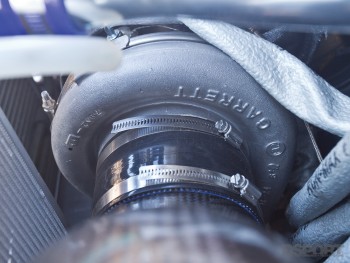BOOST TO BLAST
 With a solid 4G63 mill in place, attention shifted to pressurizing the cylinders of the engine. Tazawa fitted a Garage G-Force manifold to the exhaust ports. The tubular manifold channels high-enthalpy gasses into the turbine of an HKS T04Z turbocharger. While spent gasses leave the turbine through a Garage G-Force titanium dual exhaust, charge air generated on the compressor side feeds through custom intercooler piping to the HKS front-mount intercooler. Once heat is rejected through the intercooler, the chilled air flows to the intake ports by way of a Hypertune intake manifold.
With a solid 4G63 mill in place, attention shifted to pressurizing the cylinders of the engine. Tazawa fitted a Garage G-Force manifold to the exhaust ports. The tubular manifold channels high-enthalpy gasses into the turbine of an HKS T04Z turbocharger. While spent gasses leave the turbine through a Garage G-Force titanium dual exhaust, charge air generated on the compressor side feeds through custom intercooler piping to the HKS front-mount intercooler. Once heat is rejected through the intercooler, the chilled air flows to the intake ports by way of a Hypertune intake manifold.
 Although boost is essential for increasing output, supplying adequate fuel is just as important to ensure proper air-to-fuel ratios. To provide an uninterrupted supply, a custom fuel surge tank works with SARD fuel pumps to push 100-octane pump gas to the quartet of 1,200 cc/min DeatschWerks injectors. Depending on an HKS EVC VI for boost control and an F-CON V Pro to map the fuel and ignition tables, the wagon spun the hubs of a Dynapack chassis dyno to the tune of 680 horsepower.
Although boost is essential for increasing output, supplying adequate fuel is just as important to ensure proper air-to-fuel ratios. To provide an uninterrupted supply, a custom fuel surge tank works with SARD fuel pumps to push 100-octane pump gas to the quartet of 1,200 cc/min DeatschWerks injectors. Depending on an HKS EVC VI for boost control and an F-CON V Pro to map the fuel and ignition tables, the wagon spun the hubs of a Dynapack chassis dyno to the tune of 680 horsepower.
DON’T SHEAR GEARS
 With power handled, getting that power to the ground came next. While the EVO MR’s six-speed transmission enjoys the benefit of shorter gearing and a sixth gear, it’s not as durable as the non-MR five-speed transmission. Rather than compromising the possible top-speed capabilities by using a five-speed box, a Pfitzner Performance Gearbox six-speed gear set replaced the factory spurs in the transmission housing.
With power handled, getting that power to the ground came next. While the EVO MR’s six-speed transmission enjoys the benefit of shorter gearing and a sixth gear, it’s not as durable as the non-MR five-speed transmission. Rather than compromising the possible top-speed capabilities by using a five-speed box, a Pfitzner Performance Gearbox six-speed gear set replaced the factory spurs in the transmission housing.
 The last pieces of the driveline puzzle to address were the differentials. Like the JDM EVO IX MR, the Lancer Evolution Wagon GT enjoys the benefits of Mitsubishi’s Super Active Yaw Control (AYC), which lends itself to handling performance. The Super AYC uses electronic control to distribute torque between the rear wheels to control the yaw moment on the chassis. While the system acts like an active limited-slip differential (LSD) for improved cornering performance, the objective of this wagon is to go straight as fast as possible. This means getting the power to the pavement quickly and equally between the tires. Thus, a Cusco type MZ clutch-pack LSD replaced the AYC in the diff carrier at the back.
The last pieces of the driveline puzzle to address were the differentials. Like the JDM EVO IX MR, the Lancer Evolution Wagon GT enjoys the benefits of Mitsubishi’s Super Active Yaw Control (AYC), which lends itself to handling performance. The Super AYC uses electronic control to distribute torque between the rear wheels to control the yaw moment on the chassis. While the system acts like an active limited-slip differential (LSD) for improved cornering performance, the objective of this wagon is to go straight as fast as possible. This means getting the power to the pavement quickly and equally between the tires. Thus, a Cusco type MZ clutch-pack LSD replaced the AYC in the diff carrier at the back.


